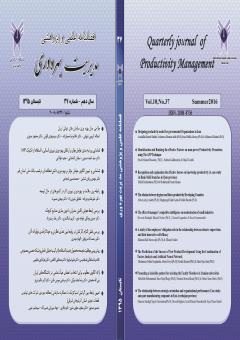تعیین رابطه بین گرایش استراتژیک با عملکرد سازمانی (مطالعه موردی: شرکت های تولیدی قطعات خودرو استان آذربایجان شرقی)
محورهای موضوعی : مدیریت بازرگانیمنصور صدیق 1 , یعقوب علوی متین 2 , داود باقری 3 , جواد میرزایی نصیر آباد 4 , سید یاسر غیبی 5
1 - عضو هیأت علمی، گروه مدیریت،واحد تبریز، دانشگاه آزاد اسلامی، تبریز
2 - استادیار گروه مدیریت صنعتی،واحد تبریز، دانشگاه آزاد اسلامی، تبریز
3 - باشگاه پژوهشگران جوان و نخبگان، واحد تبریز، دانشگاه آزاد اسلامی، تبریز
4 - کارشناسی ارشد،گروه حسابداری،واحد تبریز،دانشگاه آزاد اسلامی،تبریز
5 - -6 دانشجوی دکترای مدیریت دانشگاه قاضی آنکارا- ترکیه
کلید واژه: عملکرد سازمانی, کارت امتیازی متوازن, گرایش استراتژیک,
چکیده مقاله :
موقعیت کلیدی استراتژی کسب وکار در تصمیم گیریهای سازمانی، دلیلی است که بررسی رابطه بین استراتژی با نتایج عملکردی حاصل از آن با استفاده رویکرد کارت امتیازی متوازن را توجیه کند. این پژوهش، بر اساس هدف از پژوهش های کاربردی محسوب می شود و بر اساس چگونگی به دست آوردن داده های مورد نیاز، توصیفی و از نوع همبستگی است که در آن رابطه میان متغیرها بر اساس هدف پژوهش تحلیل می شود. جامعه آماری این تحقیق شامل 700 نفر از مدیران و صاحبان صنایع تولیدی فعال در تولید قطعات یدکی خودرو استان آذربایجان شرقی می باشد که مطابق با جدول مورگان و چرسی حجم نمونه با توجه به جامعه آماری یاد شده 195 نفر است. می توان گفت که دانش افزایی این پژوهش، به کارگیری کارت امتیازی متوازن برای بررسی این رابطه است. در نهایت با توجه به نتایج به دست آمده از پژوهش، استراتژی کسب وکار نقش تعیین کننده ای در عملکرد سازمانی دارد و ابعاد پیش فعالی، آینده نگری، تحلیلی، ریسک پذیری و تدافعی رابطه مثبت و معناداری با عملکرد سازمانی دارند.
The strategic key position of labor on organizational decision making caused the study of the relation between strategy and its performance results using balanced score-cards procedure. The research method was descriptive correlation. The statistical population included 700 people of managers and the manufacturing industries owners' active in producing auto spare parts in East Azerbaijan province. Using Morgan's table the sample size was 195 people. The results indicated that labor strategy had a positive and crucial role on organizational performance and hyperactivity foresight, analytical, risk-taking and defensive dimensions have a positive and significant relationship with organization performance.
- Icaf, R. (2007), “Organization Reconstruction”, translation by Taghi S, Dr Mardani Givi, Dr. Moridi, Industrial Management Organization, Third Edition.
- - Armstrong, M. (2004), “Human Resources Strategic Management”, Translation by Dr. Arabi, Izadi, Office of Cultural Research, Second Edition.
- El Duft, R. (2007), “Theory and Design of the Organization”, Translation by Ali Parsaiian and Mohammad Arabi, Fourth Edition, Office of Cultural Research, Tehran.
- Abedi Jafari, H., Jami, M., Bi Robayi, H. (2010), “The Challenge of Human Resource Management in Virtual Organizations. The Relationship between the Degree of Virtualization of Organizations and Organizational Commitment”, The Journal of Information Technology Management
- Ali Babayi, A. (2009), Designing and Implementing a Performance Measurement System Using Balanced Scorecard Methods and Targeted Measures, Master's Thesis, Isfahan University.
- Manian, A., Musakhani, M. (2009), “Investigating the relationship between the alignment of information technology and business with organizational performance in companies active in the field of information technology using the Structural Equation Modeling”, Information Technology Management.
- Atkinson, A.A., Waterhouse, J.H., and Wells, R.B. (2011), "A stakeholder Approach to strategic performance Measurement", Sloan Management Review Spring, 25-37
- Kaplan, R.S. and Norton, D.P. (1992), "The Balanced scorecard: Measures that Drive performance", Harvard Business Review, January-February.
- Marr, B. and Schiuma, G. (2003), "Business performance Measurement: past, present and Future", Management Decision 41/8 ,pp 680-87
- Neely, A. and Adams, C. (2002), "Perspectives on performance: The performance prism", forthcoming in Journal of Cost Management.
_||_
- Icaf, R. (2007), “Organization Reconstruction”, translation by Taghi S, Dr Mardani Givi, Dr. Moridi, Industrial Management Organization, Third Edition.
- - Armstrong, M. (2004), “Human Resources Strategic Management”, Translation by Dr. Arabi, Izadi, Office of Cultural Research, Second Edition.
- El Duft, R. (2007), “Theory and Design of the Organization”, Translation by Ali Parsaiian and Mohammad Arabi, Fourth Edition, Office of Cultural Research, Tehran.
- Abedi Jafari, H., Jami, M., Bi Robayi, H. (2010), “The Challenge of Human Resource Management in Virtual Organizations. The Relationship between the Degree of Virtualization of Organizations and Organizational Commitment”, The Journal of Information Technology Management
- Ali Babayi, A. (2009), Designing and Implementing a Performance Measurement System Using Balanced Scorecard Methods and Targeted Measures, Master's Thesis, Isfahan University.
- Manian, A., Musakhani, M. (2009), “Investigating the relationship between the alignment of information technology and business with organizational performance in companies active in the field of information technology using the Structural Equation Modeling”, Information Technology Management.
- Atkinson, A.A., Waterhouse, J.H., and Wells, R.B. (2011), "A stakeholder Approach to strategic performance Measurement", Sloan Management Review Spring, 25-37
- Kaplan, R.S. and Norton, D.P. (1992), "The Balanced scorecard: Measures that Drive performance", Harvard Business Review, January-February.
- Marr, B. and Schiuma, G. (2003), "Business performance Measurement: past, present and Future", Management Decision 41/8 ,pp 680-87
- Neely, A. and Adams, C. (2002), "Perspectives on performance: The performance prism", forthcoming in Journal of Cost Management.


